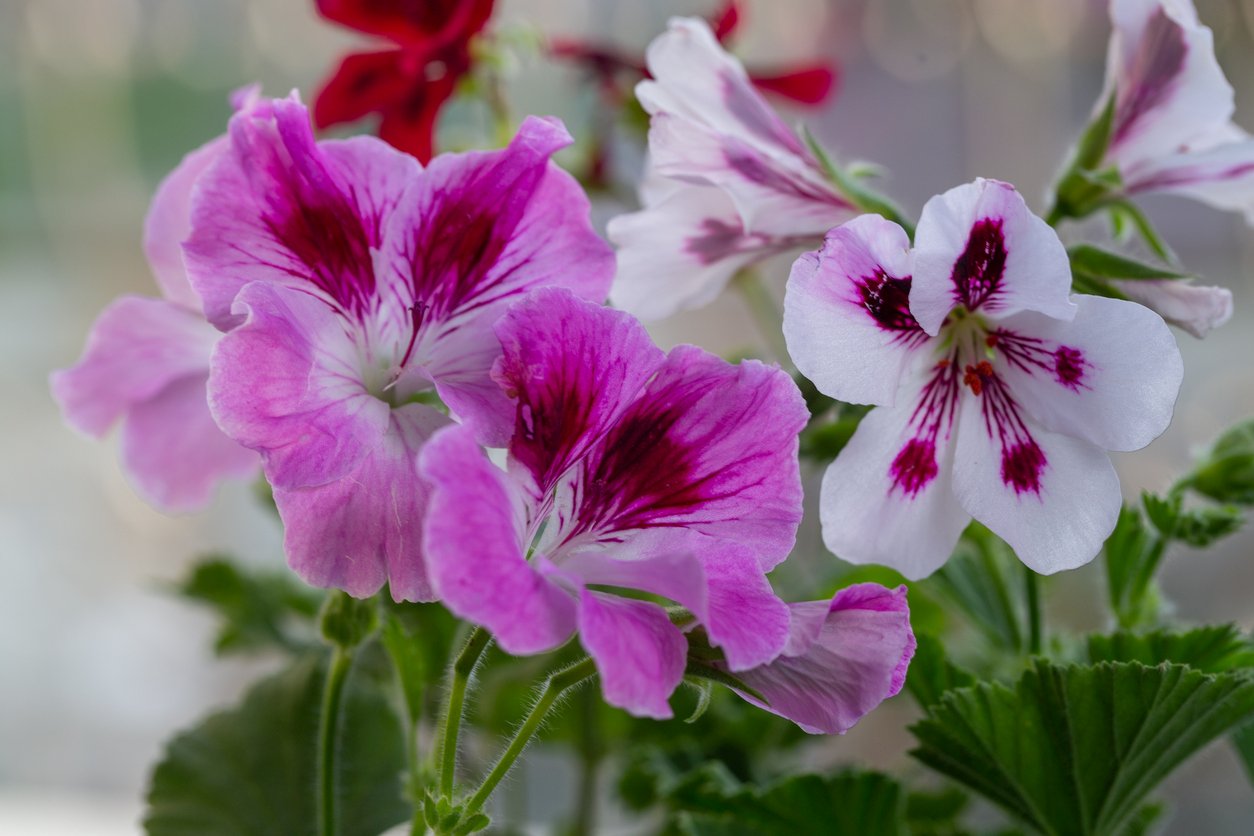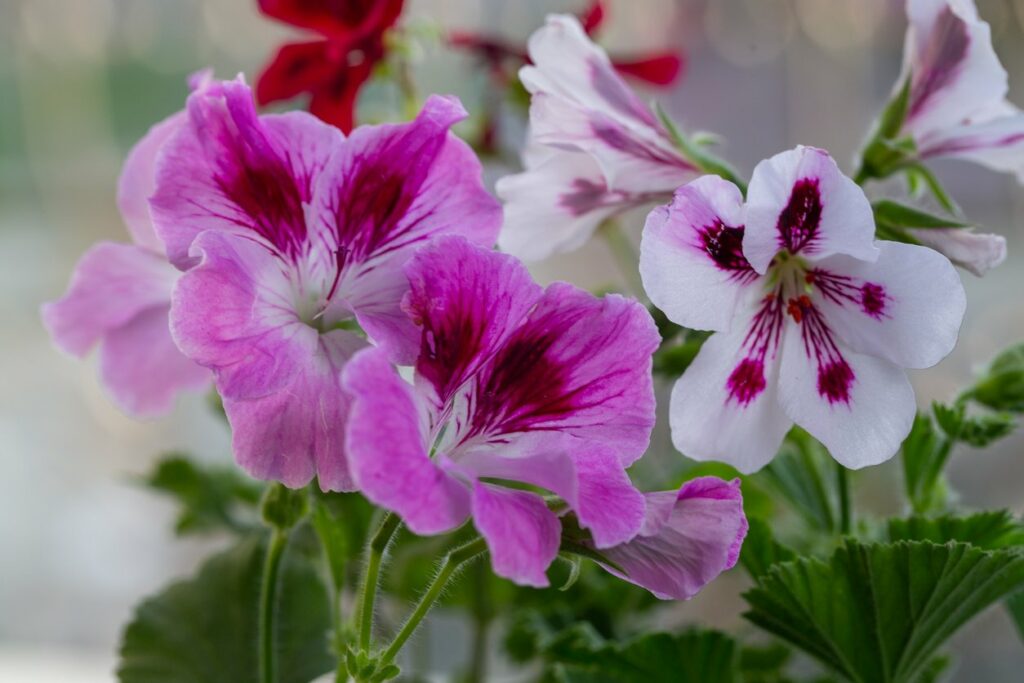Scented Geranium Care: How To Grow Scented Geranium In Your Garden
While many plants have scented flowers, the scented geranium has fragrant leaves. Whether you brush against them or hold the leaves in your hand, the majestic scent releases and fills up the air. Many gardeners grow the scented geranium because it gives them fragrance on tap. Why wait for the flowers to bloom when you have leaves spreading their aroma all year round.
The leaves are not only a source of fragrance but you can use them to make tea as well. In the kitchen, the chopped leaves give a distinct flavor to soups, pasta dishes, and even grilled fish. It also has many health benefits and its aroma has a calming effect on women during labor. So you’ll have many uses for this aromatic plant and you can explore more culinary options as well. This article covers growing and caring for the scented geranium in your garden.
Scented Geranium at a Glance
The scented geranium (Pelargonium) is a native of South Africa although it has no relationship to geraniums as a species. It’s not clear where they got that name but they have been around since Victorian Britain. Mainly grown for their aromatic leaves, they are not really perennials and are considered annuals.
The average height of the fully grown plant is about 3 feet. However, you can have varieties as small as one foot high. They can grow between one and two feet wide making them ideal as indoor plants. The foliage is often green with blue shades.
The fragrance of the scented geranium varies widely between different species and cultivars of this fascinating plant. The leaves range from spicy to chocolaty, smooth, or fruity scents. As for the flowers, they are either white or pale pink and bloom in the summer.
Scented Geranium Varieties
As with many gardening plants, the more popular they are the more cultivars they have. Horticulturalists have been experimenting with the scented geranium for centuries and now you have an amazing variety of species and cultivars to choose from.
- Apricot-scented geranium: It has a distinct fruity smell that has a sweet flavor to it. It is mainly a shrub with stunning bright green leaves. The flowers bloom in the early spring and are either red or pinkish. It has hardiness zones between 9 and 11 and averages 20 inches high.
- ‘Chocolate Mint’ scented geranium: As the name implies, the large leaves of this species smell chocolaty with a hint of mint. The leaves are bright green with dark red patches in the middle and maroon veins. It averages about 3 feet high and has hardiness zones between 9 and 11. The flowers are usually lavender.
- Fernleaf scented geranium: There’s little doubt what inspired this cultivar. The leaves are thin and full of teeth almost like fern leaves. The fragrance, however, is more like a pine tree than ferns. It averages about 36 inches high and 24 inches wide. This cultivar has the same hardiness zones as the two species above.
- ‘Angel Eyes Light’ scented geranium: A small plant that only grows to 15 inches high and the same in width. The flowers here are bigger and more distinctive than in other species. They come in different shades of pink.
- Coconut-scented geranium: The leaves look more like scallops and are light green in color. This is a spreader that grows wide more than high. You can use it as a ground cover plant as it reaches 18 inches wide and only 10 inches high. In some states, it is considered a weed.
- ‘French Lace’ scented geranium: Both the leaves and flowers are highly ornamental. The green leaves have deep grooves and creamy edges. They smell like lemons. The flowers are pale pink and bloom atop the colorful foliage. This species has an average size of 18 inches high.
- Rose-scented geranium: The hairy leaves are lobed and almost tubular. This species is grown commercially to produce geranium oil. The flowers are pink and exquisite looking with dark pink patterns in the middle. The plants grow to a maximum height of 3 feet and the same in width.
All these cultivars grow in hardiness zones between 9 and 11 so they prefer warm climates. However, if you grow it indoors as a houseplant, it will thrive no matter what the weather is like outside. As long as it gets adequate light, it won’t complain.
How to Grow the Scented Geranium
Thanks to their versatility and ability to adapt both indoors and outdoors, scented geraniums are easy to grow. You can grow them any time of the year as a houseplant. But if you worry about cold winters and their impact on garden plants, then it’s best to plant the cutting in the spring. Here’s how to grow the scented geranium in easy steps.
- From a healthy plant, select a stem with at least three sets of leaves growing on it.
- Use a sterilized knife or clean pruning scissors to cut the stem.
- Clean the base of the cutting and remove any leaves that could end up buried in the soil.
- Select a small pot with plenty of drainage holes at the bottom.
- Fill the pot with a regular potting mix and add one-third portion of sand or perlite. This improves the aeration and drainage of the soil.
- Dip the cutting in a hormone growth powder and shake off the excess powder.
- Dig a hole in the soil about 3 inches deep and plant the cutting. Backfill the soil to ensure the cutting can stand upright.
- Make sure no leaves are near or under the soil surface. They will rot in the wet soil.
- Water the soil enough to make it moist but not soaked.
- Snip off the top of the cutting to trigger the cutting to focus on growing roots, not new leaves.
- Don’t overwater the pot. Allow it to dry out before you water it again.
- Keep the pot in a warm place outside away from the direct sunlight. You can also keep it indoors in a brightly lit place.
- After a week or more, the cutting develops roots and new leaves sprout at the top of the plant.
Scented Geranium Care
One of the best features of scented geraniums is that they’re not fussy about soil or growing conditions. Some varieties tolerate the cold weather while others can grow in shaded areas. And when you want to spread their fragrance around, just mist them on a hot summer day.
Soil
It goes without saying that well-drained soil is a basic requirement of flowering plants whether they are perennials or annuals. This is why you should add sand or perlite to the potting mix when you plant the scented geranium. The roots of the plant prefer more air pockets in the soil than water. You can also mix in organic materials if you think the sandy soil dries out too fast. They help with water retention and also provide the plant with slow-release nutrients.
Watering
Whether they grow in pots or outdoors, scented geraniums don’t need too much watering. At best you should water the soil to make it moist. Overwatering can kill the plants even in the summer months. As a rule of thumb, you should allow the top few inches of the soil to go dry before you water the plant. In a pot where the soil dries out faster, you can test the topsoil with your finger and water it if it’s dry. In areas where you get high humidity levels, avoid watering or misting the leaves since that could encourage fungal infestations.
Pruning
While the scented geranium is compact in size, it is notorious for its fast growth rates. Within weeks the cutting you had planted becomes a lush green plant with plenty of branches and leaves. As you might expect, you will need to prune at least once a year. The best time is in late summer after the last flower has dropped. You shouldn’t prune it in the fall since the new shoots will not survive in the cold winter months. Other than that, you should remove dead branches and fallen flowers regularly to maintain the ornamental aspects of the plant.
Pests and Diseases
With humidity and warm weather comes insects. That’s just a fact of life that gardeners have to live with. So when growing the scented geranium, be prepared to deal with some pesky insects and health conditions that affect your plant. You have whiteflies, slugs, and snails to worry about. Whiteflies feed on the juicy leaves and sap in the stems which could ruin the look and ornamental appeal of the plants.
As for slugs and snails, they could kill the plant outright if you don’t intervene. Use neem oil to eliminate whiteflies. If the infestation is widespread, you might have to get rid of the plant altogether and start a new one. It also helps to space out the plants to allow ventilation. This prevents fungal infestations and insects from damaging the plant.
Repotting
When growing the scented geranium in a pot, repotting becomes a necessity. The roots grow just as fast as the leaves and pretty soon, the pot gets too small for the plant. The best time to repot is in the spring before the annual growth spurt. Cramped roots impact the growth of the plant and its fragrant leaves. Choose a pot one measure bigger than the current one. Fill it with the same potting mix and transport the plant to the new pot. Check the roots before repotting and make sure they are healthy.

